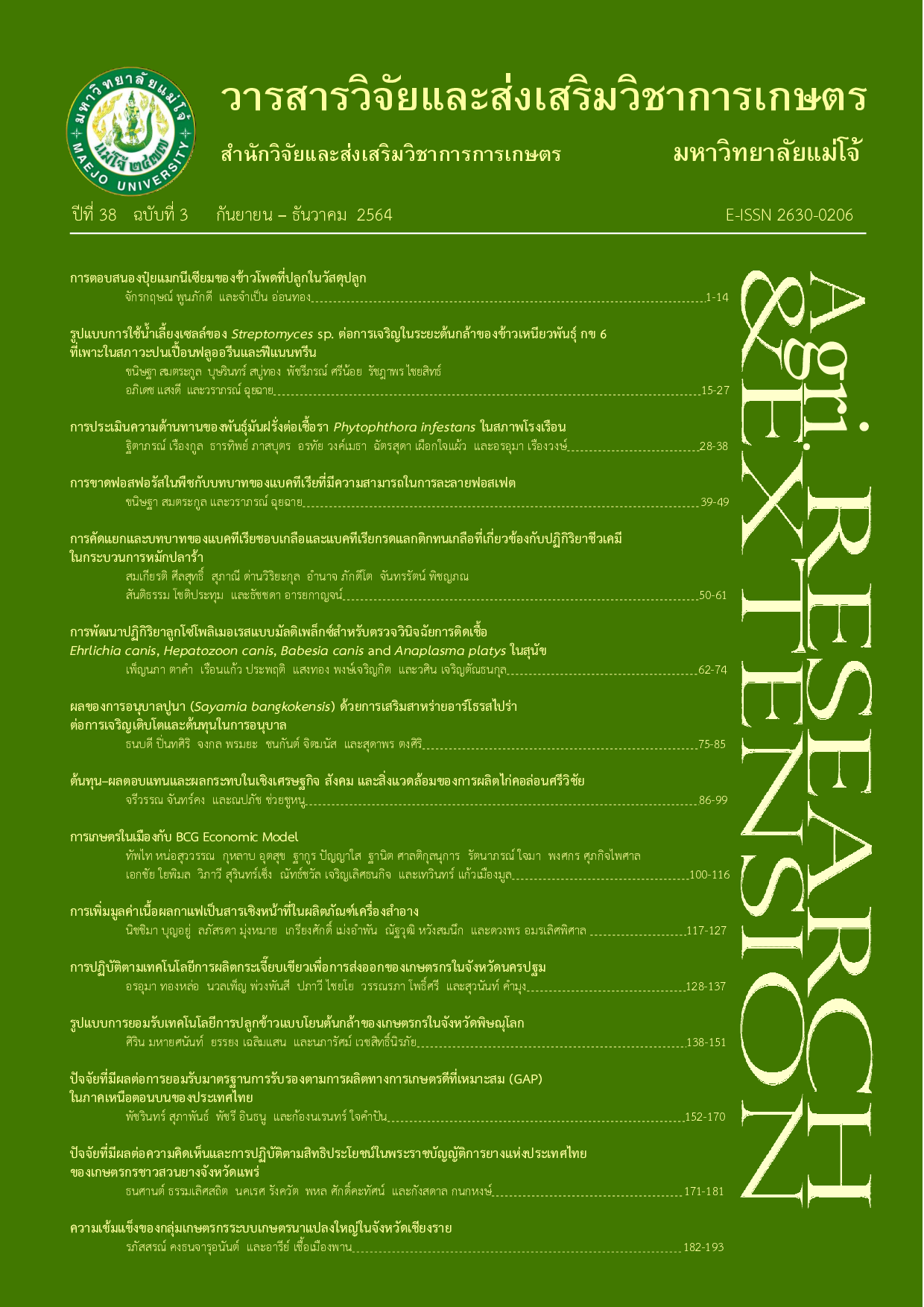การพัฒนาปฏิกิริยาลูกโซ่โพลิเมอเรสแบบมัลติเพล็กซ์สำหรับตรวจวินิจฉัยการติดเชื้อ Ehrlichia canis, Hepatozoon canis, Babesia canis and Anaplasma platys ในสุนัข
คำสำคัญ:
Ehrlichia canis, Hepatozoon canis, Babesia canis, Anaplasma platys, ปฏิกิริยาลูกโซ่โพลิเมอเรสแบบมัลติเพล็กซ์บทคัดย่อ
งานวิจัยนี้พัฒนาเทคนิคปฏิกิริยาลูกโซ่โพลีเมอเรสแบบมัลติเพล็กซ์ เพื่อช่วยในการวินิจฉัยการติดเชื้อ ก่อโรคพยาธิในเลือดในสุนัข โดยเทคนิคที่พัฒนาขึ้น ต่อยอดจากเทคนิคที่ผู้วิจัยพัฒนาขึ้นก่อนหน้านี้ ซึ่งสามารถตรวจพบเชื้อก่อโรคได้ 3 ชนิด ได้แก่ Ehrlichia canis, Hepatozoon canis (โปรโตซัว) และ Babesia canis (โปรโตซัว) โดยเทคนิคที่พัฒนาขึ้นใหม่นี้สามารถตรวจหายีน VirB9 ของเชื้อ E. canis, ยีน 18S rRNA ของเชื้อ H. canis และ B. canis และยีน groEL ของเชื้อ Anaplasma platys จากตัวอย่างเลือดของสุนัข เชื้อก่อโรคทั้งสี่ชนิดมีพาหะร่วมกัน คือ เห็บสุนัขสีน้ำตาล (Rhipicephalus sanguineus) และทำให้สุนัขแสดงอาการป่วยที่คล้ายกัน ได้แก่ ซีด เบื่ออาหาร และอ่อนแรง วิธีการวินิจฉัยการติดเชื้อเหล่านี้ ในปัจจุบันใช้วิธีการย้อมฟิล์มเลือดบางด้วยสี Wright–Giemsa วิธี Immunochromatographic เพื่อตรวจหาแอนติบอดี และวิธีปฏิกิริยาลูกโซ่โพลิเมอเรส ในวิธีต่างๆ เหล่านี้วิธีปฏิกิริยาลูกโซ่โพลิเมอเรสให้ความไวในการตรวจพบเชื้อสูงที่สุด แต่ใช้ระยะเวลาในการตรวจนานที่สุด โดยเฉพาะอย่างยิ่งเมื่อตรวจหาเชื้อก่อโรคทีละเชื้อ เทคนิคปฏิกิริยาลูกโซ่โพลิเมอเรสแบบมัลติเพล็กซ์ ที่พัฒนาขึ้นนี้จะช่วยลดระยะเวลาในการวินิจฉัยการ ติดเชื้อโรคทั้งสี่ชนิดได้
เอกสารอ้างอิง
Allison, R.W. and S.E. Little. 2013. Diagnosis of rickettsial diseases in dogs and cats. Veterinary Clinical Pathology 42(2): 127-144.
Baneth, G. 2011. Perspectives on canine and feline hepatozoonosis. Veterinary Parasitology 181(1): 3-11.
Baneth, G., S. Harrus, A. Gal and I. Aroch. 2015. Canine vector-borne co-infections: Ehrlichia canis and Hepatozoon canis in the same host monocytes. Veterinary Parasitology 208(1): 30-34.
Bell, C.A. and R. Patel. 2005. A real-time combined polymerase chain reaction assay for the rapid detection and differentiation of Anaplasma phagocytophilum, Ehrlichia chaffeensis, and Ehrlichia ewingii. Diagnostic Microbiology and Infectious Disease 53: 301-306.
Carrade, D.D., J.E. Foley, D.L. Borjesson and J.E. Sykes. 2009. Canine granulocytic anaplasmosis: a review. Journal of Veterinary Internal Medicine 23: 1129-1141.
Chomel, B. 2011. Tick-borne infections in dogs-an emerging infectious threat. Veterinary Parasitology 179(4): 294-301.
Harrus, S. and T. Waner. 2011. Diagnosis of canine monocytotropic ehrlichiosis (Ehrlichia canis): an overview. The Veterinary Journal 187: 292-296.
Jittapalapong, S., O. Rungphisutthipongse, S. Maruyama, J.J. Schaefer and R.W. Stich. 2006. Detection of Hepatozoon canis in stray dogs and cats in Bangkok, Thailand. Annals of the New York Academy of Sciences 1081: 479-488.
Kongklieng, A., T. Thanchomnang, P.M. Intapan, T. Boonmars, P. Janwan, O. Sanpool, V. Lulitanond, P. Taweethavonsawat, S. Chungpivat, N. Morakote and W. Maleewong. 2014. Detection of Ehrlichia canis in canine blood samples by real-time fluorescence resonance energy transfer (FRET) PCR and melting curve analysis. The Southeast Asian Journal of Tropical Medicine and Public Health 45(5): 1149-1156.
Laummaunwai, P., P. Sriraj, R. Aukkanimart, T. Boonmars, S. Boonjaraspinyo, S. Sangmaneedet, P. Potchimplee, P. Khianman and W. Maleewong. 2014. Molecular detection and treatment of tick-borne pathogens in domestic dogs in Khon Kaen, northeastern Thailand. The Southeast Asian Journal of Tropical Medicine and Public Health 45(5): 1157-1166.
Little, S.E. 2010. Ehrlichiosis and anaplasmosis in dogs and cats. Veterinary Clinics of North America; Small Animal Practice 40(6): 1121-1140.
Liu, M., N. Ruttayaporn, V. Saechan, C. Jirapattharasate, P. Vudriko, P.F. Moumouni, S. Cao, T. Inpankaew, A.P. Ybañez, H. Suzuki and X. Xuan. 2016. Molecular survey of canine vector-borne diseases in stray dogs in Thailand. Parasitology International 65(4): 357-361.
Modrý, D., R. Beck, K. Hrazdilová and G. Baneth. 2017. A review of methods for detection of Hepatozoon infection in carnivores and arthropod vectors. Vector-Borne and Zoonotic Diseases 17(1): 66-72.
Nithikadpanich, C., P. Takam and W. Charerntantanakul. 2019. Development of multiplex polymerase chain reaction for simultaneous detection of Ehrlichia canis, Hepatozoon canis and Babesia canis in canine blood. Journal of Agricultural Research and Extension 36(2): 80-90. [in Thai]
Pantchev, N., S. Pluta, E. Huisinga, S. Nather, M. Scheufelen, M.G. Vrhovec, A. Schweinitz, H. Hampel and R.K. Straubinger. 2015. Tick-borne diseases (Borreliosis, Anaplasmosis, Babesiosis) in German and Austrian dogs: Status quo and review of distribution, transmission, clinical findings, diagnostics and prophylaxis. Parasitology Research 114(Suppl.1): S19-54.
Peleg, O., G. Baneth, O. Eyal, J. Inbar and S. Harrus. 2010. Multiplex real-time qPCR for the detection of Ehrlichia canis and Babesia canis vogeli. Veterinary Parasitology 173(3-4): 292-299.
Piratae, S., K. Pimpjong, K. Vaisusuk and W. Chatan. 2015. Molecular detection of Ehrlichia canis, Hepatozoon canis and Babesia canis vogeli in stray dogs in Mahasarakham province, Thailand. Annals of Parasitology 61(3): 183-187.
ดาวน์โหลด
เผยแพร่แล้ว
รูปแบบการอ้างอิง
ฉบับ
ประเภทบทความ
สัญญาอนุญาต
บทความนี้ได้รับการเผยแพร่ภายใต้สัญญาอนุญาต Creative Commons Attribution-NonCommercial-NoDerivatives 4.0 International (CC BY-NC-ND 4.0) ซึ่งอนุญาตให้ผู้อื่นสามารถแชร์บทความได้โดยให้เครดิตผู้เขียนและห้ามนำไปใช้เพื่อการค้าหรือดัดแปลง หากต้องการใช้งานซ้ำในลักษณะอื่น ๆ หรือการเผยแพร่ซ้ำ จำเป็นต้องได้รับอนุญาตจากวารสาร





